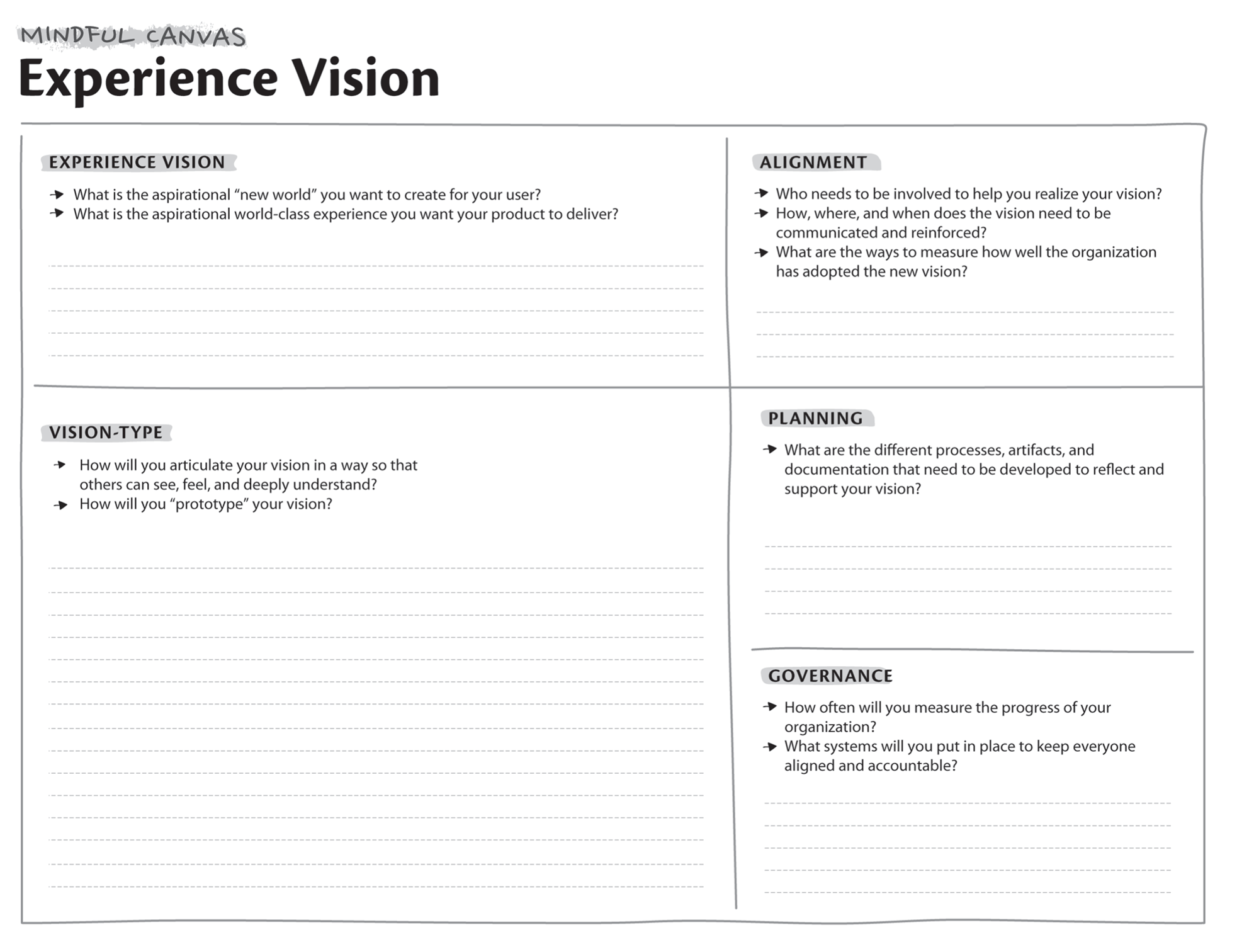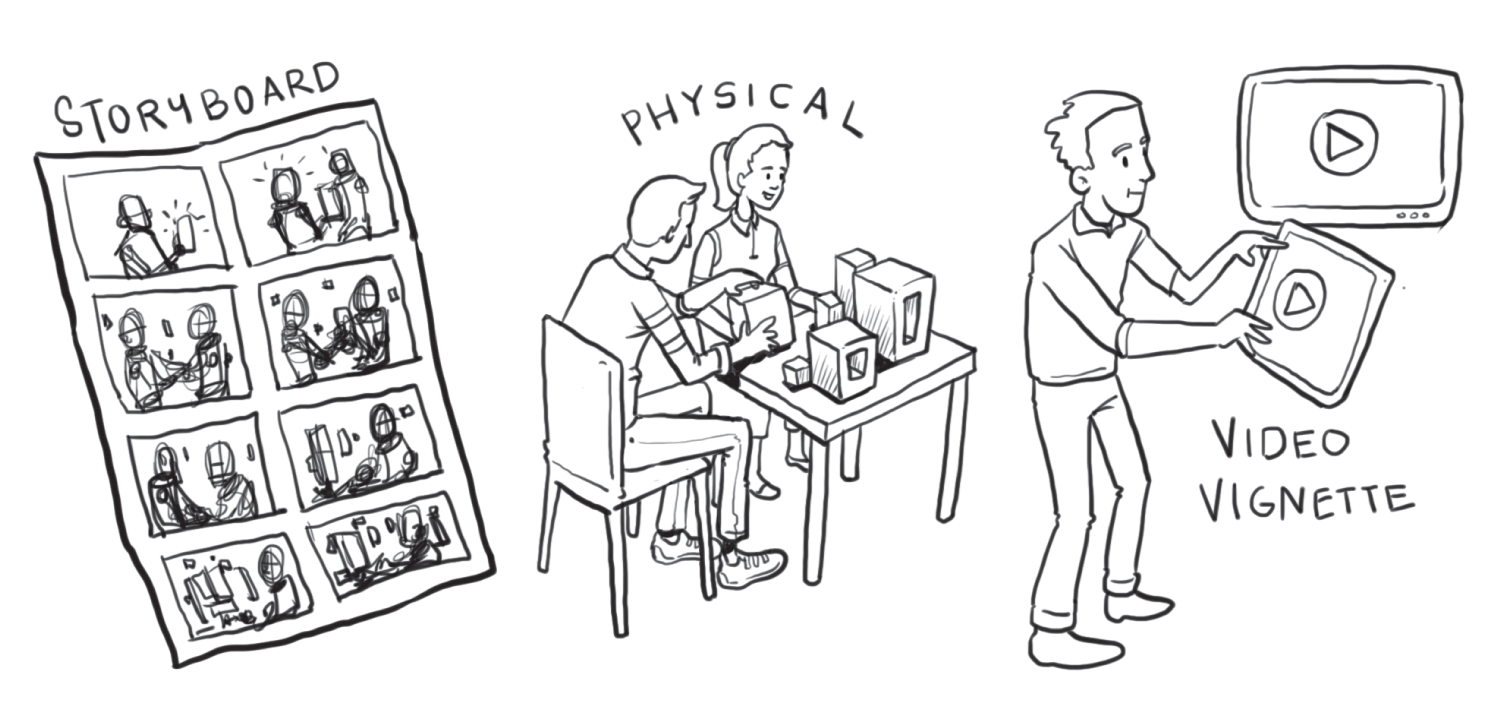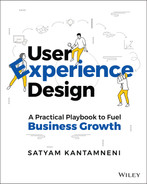CHAPTER 20
EXPERIENCE VISION PLAY: How do I create an experience vision that activates my organization?
Most of the organizations we interact with do not have a clear vision for their users’ experience. An experience vision is the aspirational world‐class experience you want your users to have and it’s a north star for your team to understand, rally around, and align with on a consistent basis. The experience vision play will help you understand how to create and activate an effective vision in your organization.

Who Are the Key players in the Experience Vision play?
| ROLE | WHO’S INVOLVED | RESPONSIBILITIES |
|---|---|---|
 DRIVER |
|
|
 CONTRIBUTOR | Peer practitioners, design collaborators (e.g. product manager, engineering manager) |
|

THE HOW
To run an effective experience vision play, you need to be mindful of :
1. Clearly Defining the EXPERIENCE VISION
To define a experience vision, identify all of the users who exist in the context of your system (Chapter 18: “Experience Ecosystem Play”). These could be external or internal users: a paying customer, a partner who helps deliver great customer experiences, an employee who orchestrates the behind‐the‐scenes.
For the key users that matter to the business, build the experience roadmap and prioritize the most critical experiences and the related needs and problems for the user (Chapter 19: “Experience Roadmap Play”).
For the identified top experiences and problems through a market baselining play (Chapter 32: “Experience Benchmarking Play”) further identify the most transformed experiences (MTE) by looking for inspirations and market analysis.
With the above understanding of the MTE’s, answer this question:
What is the aspirational “new world” experience you want to create for your user as they navigate through your system?
Try to describe your answer in your words. Ideally you should be able to complete statements such as:
- “We will create a world where [user]…”
- “Imagine a world … where magically [describe experience] will happen in this [context].”
Statements such as these will help you articulate your experience vision.
- We will create a world where merchants can interact with customers anywhere in the world.
- Imagine a world where magically all the top candidates in the market will automagically be identified based on your previous interview notes, within seconds of you posting the role.
Collaboratively, ideate, and brainstorm the best experience that you would like to give the users of your system. An experience where all their identified pain points, inefficiencies as well as needs have been taken care of.
2. How Do You Prototype Your Vision, That is, How You VISION‐TYPE It
Convert your vision from words into a format that allows others in your organization to see, hear, and feel the vision. Clickable screens are a classic “prototyping” option, but there are many other methods that can achieve the outcome in a more efficient and effective way. Storyboarding, enacting, and drawing a series of sketches are engaging and stimulating ways to communicate your vision. Or you can think even further out of the box and do a skit or make a short film. The goal is to show others the vision rather than telling them the vision. It’ll be more effective and powerful when others can visualize the world that you see.

3. Socializing the Vision and Vision‐Type for Organizational ALIGNMENT
Now it’s time to start bringing your experience vision to life.
- Stakeholder involvement: First and foremost, identify the key individuals and departments within your organization that will bring this vision to life. Mobilize and rally them to align with the future‐state experiences your company will offer. A great vision is contagious, and everyone should know the story and ask, “What will get us to the vision?”
- Communication plan: Second, you need a robust communication plan. Think about the different platforms and media you can use to share, reinforce, and implement your vision. Build repetition and a regular cadence into your communication, sensitizing the broader team enough for the vision to take on a life of its own.
- Alignment: Lastly, align your team on the plan and outcomes by identifying the target experience metrics (Chapter 28: “Experience Metrics Play”) you are aiming for and the plan you will follow to get there (Chapter 35: “Product Experience Planning Play”). Remember that you will be working cross‐functionally; therefore, your roadmaps should operate in sync and toward the same milestones.
4. Proper PLANNING to Set the Vision in Motion
The vision‐type articulates the north star, while the experience roadmap (Chapter 19: “Experience Roadmap Play”) provides you a roadmap to navigate toward the vision. Use the roadmap to obtain a holistic picture of the experience and what opportunities the team should prioritize.
Remember to mobilize every person and consider every artifact your organization produces, both internally and externally. They all play a role in creating a holistic and magical experience for the user.
Then, run micro‐experiments that will help you refine and perfect the experience. Measure, iterate, and measure again.
5. Sustaining Progress through Ongoing GOVERNANCE
This play doesn’t stop once you’ve created your vision. Keep going back to the vision. Has it evolved as a result of new technology or capabilities introduced in the market?
Use the experience and business metrics to benchmark how successful you are as you move closer to your vision.
Don’t discard elements of the vision that were not prioritized early. Continue to curate your vision plan, as what may not be viable now may be viable in a few years’ time.
IN ORDER TO MAXIMIZE THE VALUE OF THIS PLAY
- Define the vision before execution.
- Communicate the outcome of the future experience. Refrain from specifying how the design would achieve that outcome.
- Understand that “user” doesn’t only refer to paying customers. Users can also include the individuals or organizations who contribute to a better end‐user experience.
- Have a vision for each of the users that matter in your organization.
- Give your vision a name that everyone can easily anchor to and recall.
- Enlist others for help. Build a community of advocates so that the words will travel further.
- Practice curating your vision on a regular basis. What may not be feasible now may become possible as time progresses.
 RELATED PLAYS
RELATED PLAYS
- Chapter 14: “User Empathy Play”
- Chapter 18: “Experience Ecosystem Play”
- Chapter 19: “Experience Roadmap Play”
- Chapter 28: “Experience Metrics Play”
- Chapter 32: “Experience Benchmarking Play”
- Chapter 34: “Design Problems and Opportunities Play”
